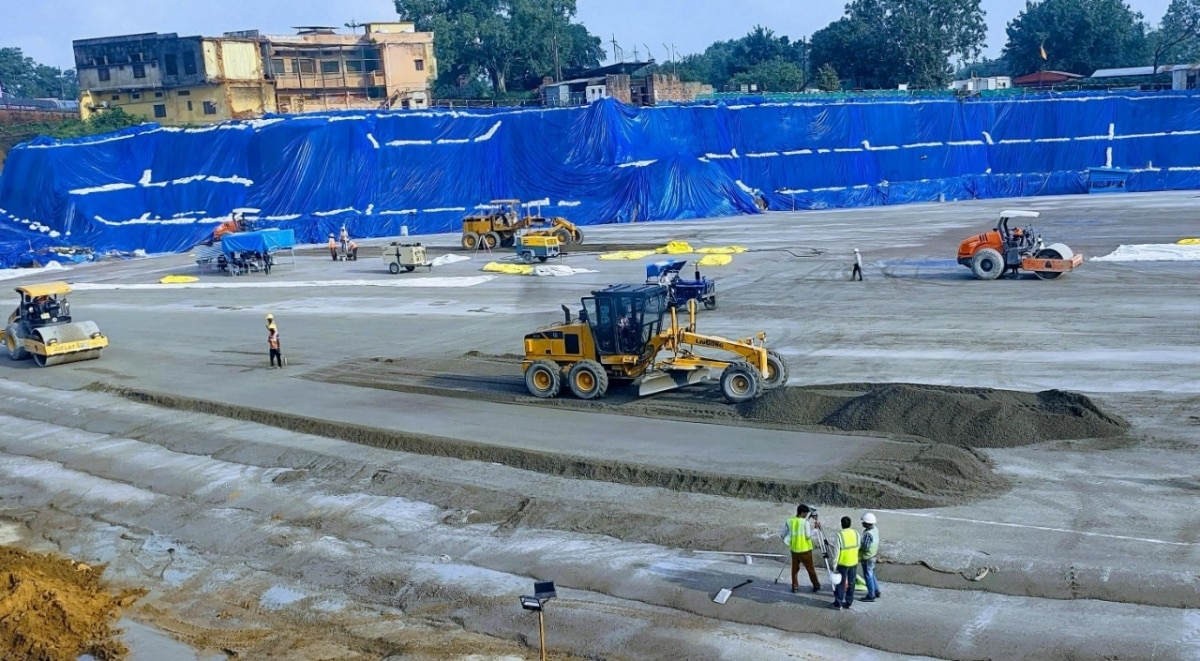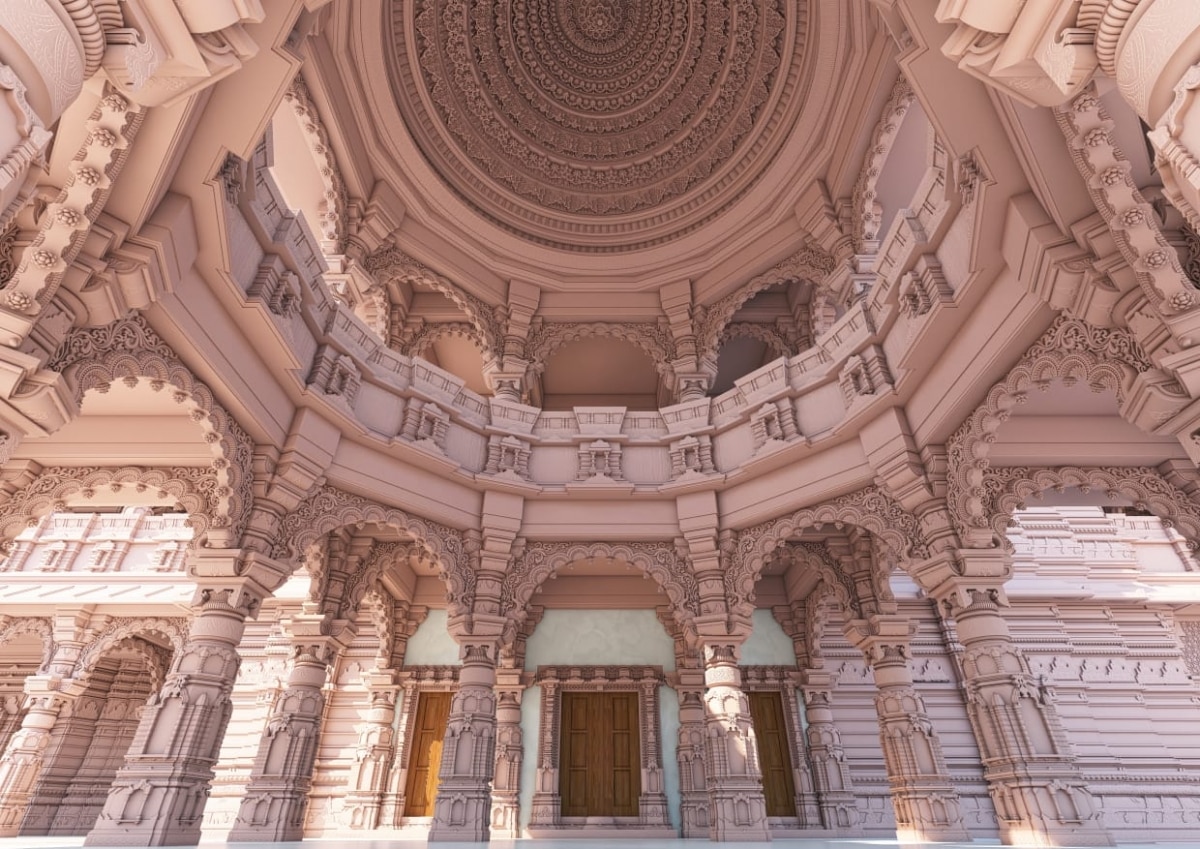Ayodhya's Ram temple to open for devotees by December 2023 | Exclusive details
Devotees will be able to catch a glimpse of the Ram temple in Ayodhya by December 2023, sources told India Today. The second phase of construction at the temple site is expected to begin later this year.

In Short
- PM Modi laid the foundation stone last August
- No steel or bricks will be used in construction of the temple
- The complex is being built at an estimated cost of Rs 1,000 crore
One year after PM Modi kick-started the construction of the Ram temple in Ayodhya, progress has been slow and replete with technical and logistical constraints. However, top sources in the Shri Ram Janmbhoomi Teerth Kshetra say that the temple would be partly ready by late 2023.
This is also when "darshan" for devotees is expected to begin. The assessment, for now, is that the temple will be completed by 2025.This means that by the end of 2023, the sanctum sanctorum of the temple will be ready to receive devotees.
Prime Minister Narendra Modi had laid the foundation stone for the temple in a grand ceremony on August 5 of last year. Apart from the main temple, the complex will also house a museum, digital archives and a research centre.
READ: Construction of Ram Temple in Ayodhya caught in satellite images
The timing of the opening of the partially-built temple in late 2023 will coincide with the run up to the 2024 Lok Sabha polls and the BJP is bound to get an opportunity to include it in its election campaign.
Sources in the temple trust said the size of the Ram temple complex has been raised to 110 acres compared to the 67 acre plot originally acquired by the trust. This has been done to incorporate the various religious and vaastu elements.

The entire Ram temple complex in UP's Ayodhya is being built at an estimated cost of Rs 1,000 crore.
The good news for the trust is that it has already received donations in excess of Rs 3,000 crore for the construction of the Ram temple despite a ban on foreign funds for the same, owing to the absence of Foreign Contribution Regulation Act (FCRA) clearance.
Second phase of construction to begin in December
Champat Rai, general secretary of the trust tasked with overseeing the construction of the temple complex, had told media outlets earlier this year that the Ram temple will be built on about "two and a half acres". We expect the work to be completed in three years, Rai added.
A wall called a 'Parkota' will be built around the temple, in addition to retaining walls inside the ground to protect the complex from flooding, Champat Rai said.
Filling of the foundation will be completed by the end of October, followed by the second phase involving stonework, which is expected to begin in December this year.
Temple building- Tedious task
Building a Ram temple that would match ancient Hindu temples in grandeur and longevity is proving to be a tough task for the trust. Laying the foundation of the temple has turned out to be the most time-consuming challenge.
After levelling the construction site, an 8-9 member committee of engineers was set up to finalise the kind and depth of foundation that needs to be laid for the temple complex. This committee, which conducted a soil study of the site, was composed of Professor Raju, former director of IIT-Delhi, the director of IIT-Guwahati, and engineers from Central Building Research institute (CBRI) in Roorkee.
The soil study revealed the existence of debris from past constructions to a depth of 12 metres into the ground. This was declared unstable soil for a temple with a 'shikhar' or temple top extending 161 feet from the ground.

A call on whether to lay the traditional stone foundation found in old Indian temples or opt for a modern "piled foundation" was the next big decision facing the trust. Experts from IIT-Chennai, however, suggested a different approach to ensure absolute stability and durability of the structure.
As per the technique suggested by experts from IIT-Chennai, the debris of past constructions had to be removed. A crater was then created by removing 70 lakh cubic feet of soil.
A total of 125 lakh cubic feet of material will be needed to lay the foundation in this crater. Of this, 71 lakh cubic feet of material has already been utilised.

The process to lay the foundation was then initiated using the engineered fill method which involves the use of fly ash, cement and stone ballasts of various sizes. Laying an engineered fill foundation is a painstaking job as it involves carefully placing 44 layers measuring 8 inches each. These layers are then compressed with machines in what is known as "vibro technology" (compression via vibration).
In addition, 7 feet deep "raft" level flooring will also be laid on top of the foundation apart from a 16 feet high plinth. Pillars and other elements part of the Ram temple complex will be set over this plinth.
READ: Towards a grand Ram temple: Trust collects Rs 2,500 crore in 44 days | India Today Insight
With the monsoon approaching, the construction company Larsen and Toubro wanted to halt construction since rain water can cause damage to an engineered fill foundation.
"Daily, 140 large sized trucks are bringing in materials for the foundation from locations as far as Bundelkhand region. And it is expected that the foundation will be ready by the end of September," a source in the temple trust said.
Crisis over stones for the temple
The procurement of stone ran into rough weather as court orders resulted in a halt in mining at the specific quarry from where the stone was supposed to be sourced. This sandstone mine is located in Bansi Paharpur village in Roopwas tehsil of Rajasthan's Bharatpur district.
This issue over the procurement of stone was resolved only recently. It has also been decided to carve the stones at the quarry itself and then ferry them to Ayodhya.

Interestingly, stones weighing 40,000 cubic feet, carved and dressed by expert artisans from Rajasthan, have been lying at the VHP's karyashala in Ayodhya's Karsevak Puram, barely 3 kilometres from the temple site for the last two decades.
A source in the temple trust said, "70 per cent of these stones will be used. But the final assessment will be done later as the stones have to be in sync with the new ones."
Walls to depict several religious themes
The walls of the proposed Ram temple in Ayodhya will depict several religious themes. A decision on the themes will be taken by a group of religious heads and art experts, including those from the Indira Gandhi National Centre for the Arts in New Delhi.
According to the proposed plan, copper joints instead of steel joints will be used to hold the walls together since they do not rust.
Construction work underway at site of proposed Ram temple in Ayodhya | Credits: India Today
The entire plinth, including the main place of worship, on the other hand, will be made of marble.
A study on the load-bearing capacity of the floor or plinth also took a long time. The task was handed over to the CBRI, which conducted a technical feasibility study to determine how much weight the "raft" on top of the foundation, the plinth and the stone pillars can bear, especially in case of an earthquake.
Procurement of white stone will begin only once the construction of the plinth and pillars is complete.
The temple trust is being zealous in keeping steel out of the construction process. So much so that lifts for differently-abled and senior citizens will be located outside and not inside the temple.
Massive scale of Ram temple complex
The site plan has grown to 110 acres compared to the original 67 acres made available for the temple. This was because the saints and priests prescribed a square or rectangular floor plan for the complex. Procurement of land is proving to be a time-taking feat.
An official from the Ayodhya administration said, "Land deals involve complexities. For example, the trust wanted to acquire a plot called Fakire Ram area. The owner wanted alternate land for temples existing there, matching the size of land and zero disturbances for prayers at the temples. The trust had to comply with all the conditions."
However, the trust is taking all decisions, keeping in mind the scale of the temple complex.

"On festival days like Ram Navami, 5-10 lakh people visit Ayodhya. The pressure on the new temple is going to be immense. The challenge would be how to create ease of darshan with the huge security matrix which would be in place. If that big a crowd reaches the temple during the specific prayers, each devotee would not get more than 1 second in the sanctum sanctorum," a trust member said.
To resolve such issues, the Shri Ram Janmbhoomi Teerth Kshetra has decided to create multiple sites of interest for the devotees, including a museum. The other old structures in the temple's vicinity will also be developed to ensure that every devotee does not converge at the sanctum sanctorum at the same time.
After a slew of corruption charges in land acquisition by the Opposition, to ensure transparency, the temple trust has decided to put every detail of land to be bought or bartered for the construction of the Ram temple on a website. Tata Consultancy Services (TCS) has also been roped in to create software for donors so that each donation would automatically generate a receipt.
